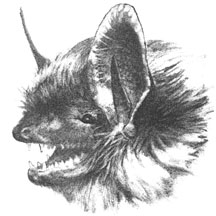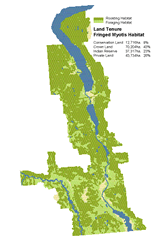|
Habitat Atlas for Wildlife at Risk
Fringed Myotis
Myotis thysanodes

Fringed
Myotis
|

- Total length: 9 cm; wingspan: 28 cm;
ears: 2 cm long.
- Weight: 7.0 grams.
- Dorsal fur is pale brown; underside fur is much
paler.
- Outer edge of the tail membrane has a distinct
fringe of small, stiff hairs that can be seen with
the naked
eye.
Status:
British Columbia Blue List
Canada: Vulnerable
Special Significance
This species is at risk because of its small British
Columbian population, vulnerability to disturbance
and low reproductive rate. Further research is required
to determine the roosting habits, diet and seasonal
movements of the Fringed Myotis. Unfortunately, bats
tend to be viewed as undesirable by many people,
when in fact they perform invaluable ecological roles,
such as keeping insect populations in check. Conservation
of riparian areas, which support a diversity of insects,
is an important factor in helping to ensure the continued
survival of this species.
Distribution
- Limited distribution in British Columbia, restricted to the arid,
low elevation valleys of the dry interior including
the Okanagan, Similkameen, Thompson, Fraser, Chilcotin valleys and
the Williams
Lake region.
- Elevational range is 300 to 800 metres.
- Found nowhere else in Canada.
Habitat
- Fringed Myotis use caves, mines, rock crevices and cliffs, wildlife
trees, and buildings for day retreats and night
roosts.
- Bats are associated with arid grasslands and ponderosa
pine-fir forests.
- Riparian areas along lakes, streams and rivers are
presumably important foraging areas for the Fringed
Myotis.
- Nursery colonies are usually located in cliffs; loose
bark in ponderosa pines may also be important
maternity sites.
- Scant information on hibernating sites suggests this
species may migrate only short distances to cave
hibernation sites; may hibernate in inaccessible
rock crevices.
Reproduction
- Breeding occurs in the fall after female bats leave maternity
roosts; fertilization occurs between the end of April and mid-May;
the gestation
period is 50 to 60 days.
- Nursery colonies are established mid- to late April
and remain stable until September; female bats
give birth in late June or early July.
- Young males are not usually reproductively active during
their first autumn; the age when females reach
sexual maturity is unknown.
- Young bats develop rapidly and are capable of limited
flight at 17 days of age; young attain adult size
by the age of 3 weeks.
Food Habits
- Fringed Myotis are late feeders; bats begin foraging an hour or
so after sunset.
- Bats eat moths, flies, beetles, leafhoppers, lacewings,
crickets, harvestmen.
- Prey is gleaned from tree trunks, branches and leaves,
and the ground.
Interesting Facts
- Named the Fringed Myotis because of the conspicuous fringe of
hairs on its tail membrane.
- Consistently found in association with many other bat
species.
Threats
- Extensive land development in the Okanagan has
eliminated or fragmented their habitat
(low elevation forest, grassland and riparian areas).
- Their low reproductive rate means a slow recovery
rate after disturbances.
- Easily disturbed by human presence; disturbance
at winter hibernating sites can be fatal.
- Sealing mine shafts reduces opportunities for summer
roosting and winter hibernation.
- Use of pesticides may reduce availability of insect
prey.
Management Considerations
- Avoid the use of pesticides, particularly near
wetlands and riparian areas.
- Protect important habitat such as low elevation
forest, grassland, and riparian areas.
- Establish a buffer zone of at least 100 metres
around roosting sites.
- Preserve old mine shafts, but erect gates to
prevent human access to caves and mine
sites.
- Refrain from entering caves or mine shafts,
particularly during winter months when
bats are hibernating.
|
References
1. Nagorsen, D.W. and R.M. Brigham. 1993. Bats of British Columbia.
Royal British Columbia Museum Handbook, Victoria, British Columbia
2. Rasheed, S.A., P.F.J. Garcia and S.L. Holroyd. 1995.
Status of the Fringed Myotis in British Columbia. Ministry of Water,
Land and Air Protection, Lands and Parks, Victoria, British Columbia
|